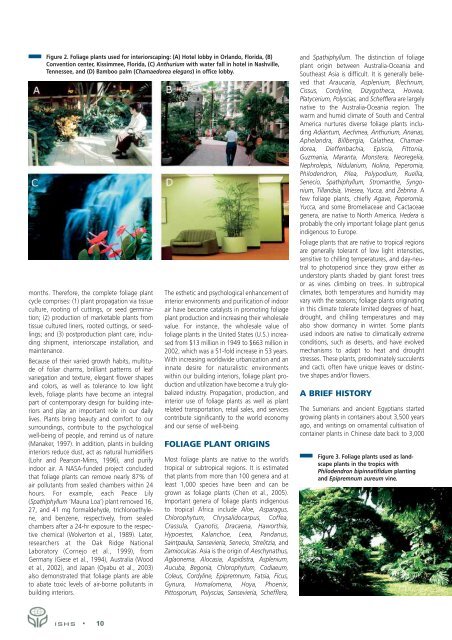The World Foliage Plant Industry - Acta Horticulturae
The World Foliage Plant Industry - Acta Horticulturae
The World Foliage Plant Industry - Acta Horticulturae
Create successful ePaper yourself
Turn your PDF publications into a flip-book with our unique Google optimized e-Paper software.
Figure 2. <strong>Foliage</strong> plants used for interiorscaping: (A) Hotel lobby in Orlando, Florida, (B)<br />
Convention center, Kissimmee, Florida, (C) Anthurium with water fall in hotel in Nashville,<br />
Tennessee, and (D) Bamboo palm (Chamaedorea elegans) in office lobby.<br />
months. <strong>The</strong>refore, the complete foliage plant<br />
cycle comprises: (1) plant propagation via tissue<br />
culture, rooting of cuttings, or seed germination;<br />
(2) production of marketable plants from<br />
tissue cultured liners, rooted cuttings, or seedlings;<br />
and (3) postproduction plant care, including<br />
shipment, interiorscape installation, and<br />
maintenance.<br />
Because of their varied growth habits, multitude<br />
of foliar charms, brilliant patterns of leaf<br />
variegation and texture, elegant flower shapes<br />
and colors, as well as tolerance to low light<br />
levels, foliage plants have become an integral<br />
part of contemporary design for building interiors<br />
and play an important role in our daily<br />
lives. <strong>Plant</strong>s bring beauty and comfort to our<br />
surroundings, contribute to the psychological<br />
well-being of people, and remind us of nature<br />
(Manaker, 1997). In addition, plants in building<br />
interiors reduce dust, act as natural humidifiers<br />
(Lohr and Pearson-Mims, 1996), and purify<br />
indoor air. A NASA-funded project concluded<br />
that foliage plants can remove nearly 87% of<br />
air pollutants from sealed chambers within 24<br />
hours. For example, each Peace Lily<br />
(Spathiphyllum ‘Mauna Loa’) plant removed 16,<br />
27, and 41 mg formaldehyde, trichloroethylene,<br />
and benzene, respectively, from sealed<br />
chambers after a 24-hr exposure to the respective<br />
chemical (Wolverton et al., 1989). Later,<br />
researchers at the Oak Ridge National<br />
Laboratory (Cornejo et al., 1999), from<br />
Germany (Giese et al., 1994), Australia (Wood<br />
et al., 2002), and Japan (Oyabu et al., 2003)<br />
also demonstrated that foliage plants are able<br />
to abate toxic levels of air-borne pollutants in<br />
building interiors.<br />
<strong>The</strong> esthetic and psychological enhancement of<br />
interior environments and purification of indoor<br />
air have become catalysts in promoting foliage<br />
plant production and increasing their wholesale<br />
value. For instance, the wholesale value of<br />
foliage plants in the United States (U.S.) increased<br />
from $13 million in 1949 to $663 million in<br />
2002, which was a 51-fold increase in 53 years.<br />
With increasing worldwide urbanization and an<br />
innate desire for naturalistic environments<br />
within our building interiors, foliage plant production<br />
and utilization have become a truly globalized<br />
industry. Propagation, production, and<br />
interior use of foliage plants as well as plant<br />
related transportation, retail sales, and services<br />
contribute significantly to the world economy<br />
and our sense of well-being.<br />
FOLIAGE PLANT ORIGINS<br />
Most foliage plants are native to the world’s<br />
tropical or subtropical regions. It is estimated<br />
that plants from more than 100 genera and at<br />
least 1,000 species have been and can be<br />
grown as foliage plants (Chen et al., 2005).<br />
Important genera of foliage plants indigenous<br />
to tropical Africa include Aloe, Asparagus,<br />
Chlorophytum, Chrysalidocarpus, Coffea,<br />
Crassula, Cyanotis, Dracaena, Haworthia,<br />
Hypoestes, Kalanchoe, Leea, Pandanus,<br />
Saintpaulia, Sansevieria, Senecio, Strelitzia, and<br />
Zamioculcas. Asia is the origin of Aeschynathus,<br />
Aglaonema, Alocasia, Aspidistra, Asplenium,<br />
Aucuba, Begonia, Chlorophytum, Codiaeum,<br />
Coleus, Cordyline, Epipremnum, Fatsia, Ficus,<br />
Gynura, Homalomena, Hoya, Phoenix,<br />
Pittosporum, Polyscias, Sansevieria, Schefflera,<br />
and Spathiphyllum. <strong>The</strong> distinction of foliage<br />
plant origin between Australia-Oceania and<br />
Southeast Asia is difficult. It is generally believed<br />
that Araucaria, Asplenium, Blechnum,<br />
Cissus, Cordyline, Dizygotheca, Howea,<br />
Platycerium, Polyscias, and Schefflera are largely<br />
native to the Australia-Oceania region. <strong>The</strong><br />
warm and humid climate of South and Central<br />
America nurtures diverse foliage plants including<br />
Adiantum, Aechmea, Anthurium, Ananas,<br />
Aphelandra, Billbergia, Calathea, Chamaedorea,<br />
Dieffenbachia, Episcia, Fittonia,<br />
Guzmania, Maranta, Monstera, Neoregelia,<br />
Nephrolepis, Nidularium, Nolina, Peperomia,<br />
Philodendron, Pilea, Polypodium, Ruellia,<br />
Senecio, Spathiphyllum, Stromanthe, Syngonium,<br />
Tillandsia, Vriesea, Yucca, and Zebrina. A<br />
few foliage plants, chiefly Agave, Peperomia,<br />
Yucca, and some Bromeliaceae and Cactaceae<br />
genera, are native to North America. Hedera is<br />
probably the only important foliage plant genus<br />
indigenous to Europe.<br />
<strong>Foliage</strong> plants that are native to tropical regions<br />
are generally tolerant of low light intensities,<br />
sensitive to chilling temperatures, and day-neutral<br />
to photoperiod since they grow either as<br />
understory plants shaded by giant forest trees<br />
or as vines climbing on trees. In subtropical<br />
climates, both temperatures and humidity may<br />
vary with the seasons; foliage plants originating<br />
in this climate tolerate limited degrees of heat,<br />
drought, and chilling temperatures and may<br />
also show dormancy in winter. Some plants<br />
used indoors are native to climatically extreme<br />
conditions, such as deserts, and have evolved<br />
mechanisms to adapt to heat and drought<br />
stresses. <strong>The</strong>se plants, predominately succulents<br />
and cacti, often have unique leaves or distinctive<br />
shapes and/or flowers.<br />
A BRIEF HISTORY<br />
<strong>The</strong> Sumerians and ancient Egyptians started<br />
growing plants in containers about 3,500 years<br />
ago, and writings on ornamental cultivation of<br />
container plants in Chinese date back to 3,000<br />
Figure 3. <strong>Foliage</strong> plants used as landscape<br />
plants in the tropics with<br />
Philodendron bipinnatifidum planting<br />
and Epipremnum aureum vine.<br />
ISHS • 10

















